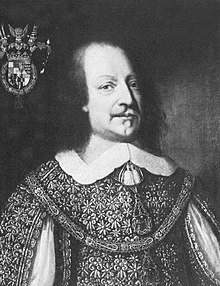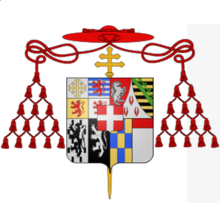Moritz of Savoy
Moritz von Savoyen ( Italian Maurizio di Savoia , born January 10, 1593 in Turin , † October 3, 1657 ibid) was a cardinal of the Roman Church .
Life
As the son of the Duke of Savoy Charles Emanuel I and his wife Catalina of Spain, he is one of the so-called dynastic cardinals. It was raised in 1607 by Pope Paul V , who also gave the cardinal the dispensation to renounce church ordinations. Maurizio di Savoia was given the opportunity to return to the worldly status if this was necessary for dynastic purposes. He actually ended his life as the husband of his niece, thirty-six years his junior.
Maurizio di Savoia's mother was the sister of Philip III. The curia feared that Maurizio's appointment as cardinal would strengthen the Spanish parliamentary group and hesitated for a long time before awarding the cardinal's hat. One of the declared goals of his father, Karl Emanuel I, was to win the cardinal's hat for his family . The family already had a cardinal's hat, as the antipope Felix V was awarded one in the 15th century as thanks for his resignation. In view of his abundant descendants, Karl Emanuel tried to win this influential award for his descendants. In 1589, he proposed to Clement VIII his son Viktor Amadeus , who was only two years old at the time , and then his fourth-born son Maurizio di Savoia. The sending of a Cardinal di Savoia to the Curia was intended to guarantee close ties with Rome. In addition, the Savoy family would then be on a par with the ruling houses of Gonzaga , d'Este , Medici and Farnese . The long hesitation of the Curia to comply with Karl Emanuel's request was mainly due to the fact that Maurizio di Savoia was the biological nephew of King Philip III through his mother . of Spain was. Above all, Pope Paul V feared that the former cardinal depository Pietro Aldobrandini would gain great influence over the Spanish faction at the Curia through the presence of a Savoy prince cardinal. Karl Emanuel only got his son through as cardinal when he consistently refused to recognize the appointments of bishops and inquisitors in his duchy.
In the consistory of December 10, 1607, Paul V complied with the wishes of Charles Emanuel I and elevated Maurizio di Savoia to the rank of cardinal . The cardinal was only 14 years old at the time. Despite his father's wish to have a cardinal interest representative at the Curia through his son, the son stayed at the court of Turin for a few years. With increasing age, Maurizio di Savoia actually played a role in Roman-Savoyard relations, even if he was not present in Rome himself. The nuncio visited him regularly and most of the letters from the cardinal nepot of Paul V. Karl Emanuel tried to promote his son's career so that it would bring the greatest possible benefit to the Duchy of Savoy . This includes that Karl Emanuel tried to ensure that his son should receive the papal fiefdom in Piedmont , the office of bishop in the Swiss diocese of Sion or the legacy in Avignon . In this way, the Savoyard sphere of influence was to be extended beyond state borders. The ambitions of Karl Emanuel I for his son were unsuccessful. It was not until 1621 that Cardinal di Savoia was assigned a title deaconry: Santa Maria Nuova , where he moved to Sant'Eustachio after a month . In 1626 he finally became cardinal deacon of Santa Maria in Via Lata (until 1642).
Maurizio di Savoia only gained influence when his brother and the ancestor of the family won the sister of the French king as a wife and Maurizio then felt more committed to French interests. With the Paul V successor Pope Gregory XV. He got along just as well as with his cardinal nepot Ludovico Ludovisi . In the conclave after the death of Gregory XV. According to the papal historian Ludwig von Pastor, he played a decisive role in the fact that Maffeo Barberini, a member of the Barberini family, received the papal tiara. This conclave was the only one he attended during his 35-year cardinalate . The relationship with Urban VIII and his cardinal nephew Francesco Barberini was not as close as with the previous pope. Although he now resided in Rome, he largely abstained from the lengthy work in papal commissions and congregations. Instead, he acted as a patron and built up an extensive art collection, among other things. The life of the cardinal and his court, however, devoured vast sums of money. In the end, his finances were so shattered that he was placed under the supervision of a council at the court of Savoy in 1634. His brother Viktor Amadeus I ruled there from 1630 onwards . In 1638 the ruling Duke of Savoy died, leaving behind two underage sons, Francesco Hyacinth and Karl Emanuel . His widow Christina of France not only claimed the guardianship of these two heirs of the House of Savoy , but also wanted to take over the reign. After Francesco Hyacinth died in October 1638, Cardinal Maurizio di Savoia - now the second in the line of succession - embroiled in a four-year war of succession together with his younger brother Thomas of Savoy and with Spanish support, Christina of France. The skilfully acting Christina of France, who in turn made use of French support, emerged victorious from this conflict. Not only was she able to keep her duchy for her son, but she also avoided the duchy falling into the hands of France. In the peace treaty of 1642 she forced Maurizio di Savoia to resign his cardinalate and to marry her only fourteen-year-old daughter Ludovica Cristina of Savoy . Maurizio di Savoia was able to return to secular status because he had not received any church ordinations due to a dispensation from Pope Paul V when he was appointed cardinal. Maurizio di Savoia initially became a governor with no political influence in the then less than glamorous city of Nice . Even in Turin he remained without any influence after his return. He died of a stroke in Turin on October 3, 1657 . He left his widow no children, but a gigantic mountain of debt.
literature
- Tobias Mörschel: Blue blood, red hat. Prince Cardinal Maurizio di Savoia. In: Arne Karsten (ed.): The hunt for the red hat. Cardinal careers in baroque Rome. Vandenhoeck & Ruprecht, Göttingen 2004, ISBN 3-525-36277-3 .
- Matthias Oberli: "Magnificentia Principis". The patronage of Prince and Cardinal Maurizio of Savoy (1593-1657). VDG, publishing house and database for humanities, Weimar 1999, ISBN 3-89739-038-8 .
Web links
- Savoia, Maurizio di. In: Salvador Miranda : The Cardinals of the Holy Roman Church. ( Florida International University website), accessed November 8, 2016.
- Entry on Maurizio di Savoia on catholic-hierarchy.org ; accessed on November 8, 2016.
| personal data | |
|---|---|
| SURNAME | Savoy, Moritz von |
| ALTERNATIVE NAMES | Savoia, Maurizio di |
| BRIEF DESCRIPTION | Cardinal of the Roman Church |
| DATE OF BIRTH | January 10, 1593 |
| PLACE OF BIRTH | Turin |
| DATE OF DEATH | October 3, 1657 |
| Place of death | Turin |


